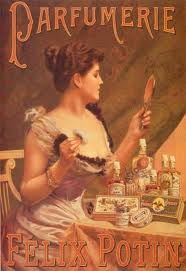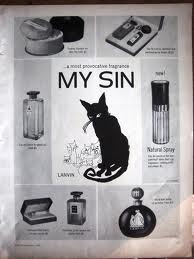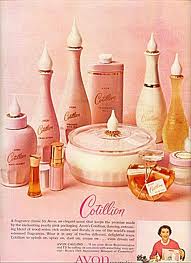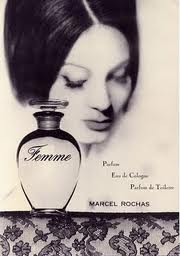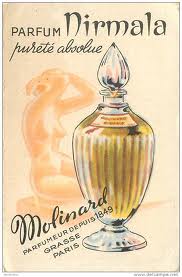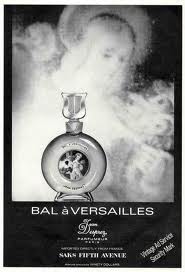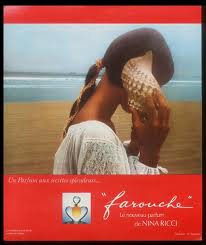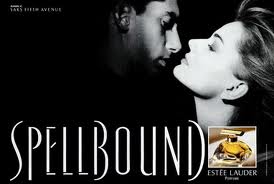“They don’t make ‘em like that anymore” When I was younger, I hated that saying. The longer I am around and the more modern perfumes I sniff, the more I wish I had been born twenty, even thirty, years earlier. With upwards of a thousand fragrances released in any given year lately, I long for the days when perfumes meant something. Gorgeous bottles filled with rich magical juices that took years to craft are now few and far between. The longer I collect and the more “vintage” perfumes I encounter, the more I realize those old folks were right. Join me, if you will, on a stroll down the decades and relive some true classics with me…
We begin in 1924, during the “Roaring Twenties”, with Lanvin’s “My Sin”, created by the mysterious Russian woman known only as “Madame Zed”. Released three years before Arpege, which is still one of Lanvin’s best sellers, this was discontinued in 1988. The initial aldehydes and citruses along with clary sage actually present rather bitter, sharp and very masculine (faux pas for this era). This composition is dark, powerful and brooding-like a force of Nature. Then crisp narcissus stands out in a veritable “Who’s Who” of floral notes, M.Zed wove myriad notes into something wholly unique and added clove for contrast. The dry down is dominated by civet…and a lot of it! Styrax, tolu balsam and a blend of smoky vetiver and dark vanilla add a foreign mystique and a hint of wicked that entices rather than frightens. Sillage: extraordinary. Longevity: excellent.
Few people know Avon was once called The California Perfume Company (est. 1886). In 1933 they resurrected a scent from 1900 called Cotillion. This is another “old lady” perfume that many dismiss. I, on the other hand, think it recaptures a bygone era, when ladies wore white gloves, dresses below the knee and still sported fancy hats. Initially rather bracing, this dries to a beautiful blend of woody notes, rich amber and honeyed flowers. Released with an accompanying line of twelve products, Cotillion was the very essence of affordable luxury in a time that seemed destitute and hopeless due to the Great Depression. This perfume feels and smells like the finest silken powder on skin and is not “loud”, but speaks clearly with poise and grace. Sillage: good. Longevity: above average.
In the 1940’s most of the world was involved in World War II. In Paris, in 1943, Edmond Roudnitska created Rochas “Femme” a perfumed homage to the beauty and power of woman. Rich fruits hint at her sweetness. Warmed with cinnamon and rosewood they echo passion and strength. The most feminine of flowers are here, yet they are subtle and tempered with dry carnations, cool iris and rosemary’s pungent aroma. Beyond the flowers and the fruits lies its true beauty: leather, oak moss and ambergris swirl together with patchouli, vanilla and musk to create the very definition of “femme fatale”. From the sultry curves of its flacon to the rich hue of its dark juice, here is the scent of women like Marlene Dietrich, Joan Crawford and Bette Davis-bold women who were not afraid to make a statement. Sillage: very good. Longevity: excellent.
Molinard’s “Nirmala” was released in 1955 and is still available today. The Molinard house began in 1849 in Grasse, France and is still family owned and operated. I have many of this company’s fragrances, but this one always shined a bit brighter than the rest to me. An opening of passion fruit and mango is kept from being too tropical or sweet by mandarin and grapefruit resulting in fruity/fresh without exuding that “plastic” fake smell of many perfumes today. The charming heart of jasmine is creamy and delicate. Many perfumes entice me with top or heart notes but fail to deliver in the ultimate finish; Nirmala just gets better and better! Exotic woods, like sandalwood and Lebanese cedar, meet nutty tonka bean and a leathery vanilla, as all of this is shrouded in a superb veil of heady musk…simply stunning! Sillage: above average. Longevity: very good.
Not as well known or as popular as Opium or Cinnabar, Jean Desprez’s “Bal a Versailles” (which predates both) is every bit as potent and equally as opulent, and the epitome of oriental. Composed of no less than twenty seven notes, this scent defies note recognition and instead blends them all seamlessly together into something heady and gorgeous. Flowers, herbs, bitter greens and citruses join forces growing stronger and more intense, almost without you knowing it. Revolutionary for its time, it “bumped” heart notes into the top and base notes into the heart-all the while resting on a thick and resinous blissful balm of resins, woods, vanilla and (again) real civet. This is the perfect perfumed portrait of an era shrouded in incense, hippies and free love tinged with Eastern philosophy and utter grooviness. Sillage: excellent. Longevity: awesome.
Nina Ricci’s “Farouche”, from 1973, fits right into the era of Women’s Lib and paved the way for sensible perfumes that joined elegant femininity with masculine crispness that said: “If they can do it, then so can we!”. Aldehydes and galbanum join forces to add a much needed boost to short-lived citrus notes and a velvety peach. A heart of delicate muguet and honeysuckle is bolstered by rose and jasmine and grounded with orris root, resulting in a clean and mean green mama, fine-tuned with just the right amount of clary sage and cardamom. Vetiver and oak moss are the stars here, when all is said and done, this leaves a divinely dry verdant trail with only vague hints of white woods and musks. Sillage: very good. Longevity: excellent. (Review based on pure parfum)
Many eighties’ scents are bombastic and were as big as the shoulder pads and hairstyles worn back then. Balmain’s “Ivoire” (released in 1980) is the antithesis of these. Inspired by a “vision in white” the perfumer saw at the opera, this perfume is classic and classy without being cloying or obnoxious. Combining such things as asafetida, violets, aldehydes, oak moss, musk and patchouli and arriving at this heavenly creation is nothing short of perfume alchemy. Radiating true grace and panache, this perfume never fails to astound me. A perfect balance of gentle strength and superb luxury, Balmain’s clothes may be prohibitively expensive; his perfumes aren’t…they just smell like they are! Sillage: excellent. Longevity: superb.
In 1991 Estee Lauder’s “Spellbound” was one of the last great perfumes released by this house, before light and clean became en vogue. Typical of a Sophia Grojsman creation, it is complex and multi-layered. A mélange of fruits and warm spices added to no less than six “power flowers” create a darkly beautiful scent that reminds me of something Endora (from Bewitched!) would wear. Opoponax, benzoin and amber…do they come any warmer or more oriental than this? This perfume is as enchanting as its name suggests, and as powerful as it sounds. Not for the faint of heart (or nose), Spellbound conjures images of strange concoctions and jars of mysterious ingredients and the juice truly lives up to that promise. Sillage: Outstanding. Longevity: phenomenal.
Disclosure: Reviews based on perfumes from my personal collection.
–John Reasinger, Editor

